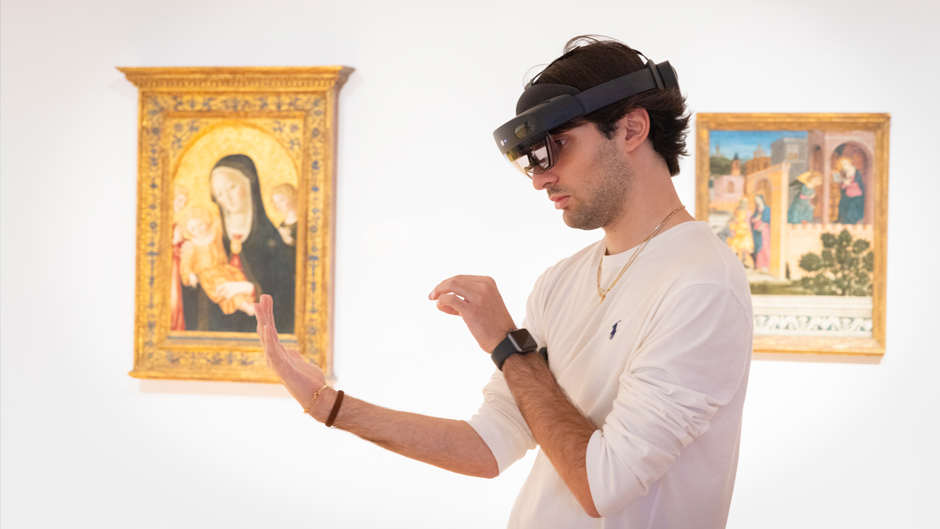Forget the simple audio tour.
Imagine walking into an art museum, donning a lightweight headset, and scrutinizing a painting from centuries ago, while modern, related works from other museums appear virtually beside the museum piece. Meanwhile, Renaissance music plays in the background.
This was the idea behind the Collection Connections, a project devised by a staff and faculty team who came together to help the Lowe Art Museum increase student and community engagement with its permanent Samuel H. Kress Collection.
“We want to create an interesting interface of time, space, and theme, that can help people make connections with contemporary art,” said Karen Mathews, an associate professor of art history at the College of Arts and Sciences, who developed the initial idea for the project.
Fast forward three years and the vision of Mathews and her team has finally come to fruition. Funded by a UMverse grant, and executed by four students, the team shared the project last week inside the Lowe to celebrate the pilot. It uses the augmented reality headset Microsoft Hololens 2 to showcase the more than 630-year-old “Madonna and Child …”, an ornate, three-paneled painting of the Virgin Mary by Italian artist Lippo Vanni. Next to it, appear three related, yet more modern pieces—paintings and a photograph—from the Pérez Art Museum Miami, as well as a piece from The Wolfsonian-Florida International University.
“We are hoping this is the first step to many of these experiences at the Lowe and at many other cultural institutions,” said Mathews, who often explores the use of virtual and augmented reality in her classes and research. “I also hope that we can continue to do this work with new technology to expand our content.”
The team that envisioned the project included Mark Osterman, the Lowe’s assistant director for technology and engagement, and Chris Mader, director of systems and data engineering at the Frost Institute for Data Science and Computing (IDSC).
“We are bridging the past to the present, but we are also educating people about different world views through this project,” Osterman added.
Overseeing the student team was Bryson Rudolph, an extended reality software engineer also at IDSC. The lead student software developer was Titus Biel, along with designer Maggie Dobra, project manager Sofia Perez-Baux, and software developer Zubaer Chowdhury. The Hololens 2 headset was leveraged to create an experience that doesn’t require hand-held controllers to click on the related works and read about them—users can just pinch their fingers. Biel and Dobra even designed a menu that will appear on top of a user’s palm when their hand is held up.
“It’s great to be a part of this, but it’s also only the beginning and this project can go so much further,” said Biel, a senior studying computer science.

Mathews agrees. She and the team are in the process of applying for several other grants to create a second pilot, ideally with more cutting-edge technology that would be widely available to the public. In the next version, Mathews wants to include 3D models of sculptures that patrons can manipulate in augmented reality. They also want to connect the Lowe with a larger network of museums.
“Hopefully, with more funding, we can bring this to other local institutions to create a network of art in South Florida, and a larger chain between museums, nationally and internationally,” Mathews added.

